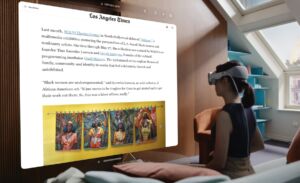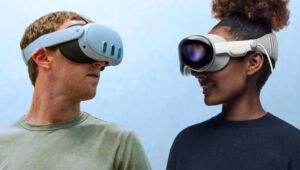Apple has taken a major step into the world of mixed-reality headsets with the highly anticipated Apple Vision Pro. By combining augmented reality (AR) and virtual reality (VR) capabilities, Apple aims to revolutionize the way we interact with digital content. While skeptics have raised concerns about the device’s potential success, the Vision Pro represents a significant leap forward in the field of mixed reality. In this article, we will explore the features and innovations of the Apple Vision Pro and discuss its potential impact on the IT industry alongside our COO, Israël Jamlean.
Hello Israël, I would like to know your opinion on this new product. Do you think all this hype is mainly marketing, or are there features that can actually make a difference?
There are a couple of new things about this headset that haven’t been done before. The mix of AR and VR is an interesting feature. In our demos with the Oculus RIft, some people felt uncomfortable because they couldn’t see who was around them. The pass-through camera could address that issue.
Content is the crucial factor for these devices: having a killer app that drives people to the platform will make a difference. However, I haven’t seen that killer app in Apple’s demo. They showcased features like Facetime and presentations, but it remains to be seen if these use cases will attract users to the platform. The applications should offset the discomfort of wearing a (quite heavy) headset on your face for prolonged periods of time by providing added value to the overall experience. While there may be certain target audiences, such as the gaming community or the adult industry, who have a higher tolerance for the discomfort, it is doubtful that the general audience will be willing to endure it.
Perhaps gaming and the adult industry are the only use cases where people are willing to tolerate the discomfort. But beyond that, I don’t think many people would be willing to put up with it. The Oculus Quest 3, which costs $500, can do most of the things that the Vision Pro is showing, but at a much lower price. Even the adoption rate for the Oculus Quest 3 isn’t very high, so I fail to see why people would spend $3500 on the Vision Pro, especially considering the discomfort and additional accessories like the tethered battery pack.
Furthermore, The AR will reduce motion sickness to some extent. However, if you’re fully immersed in VR mode, motion sickness can still be a problem. It occurs when your inner ear feels different things from what you’re seeing. So, when you see motion on the screen while your avatar is moving, but you don’t feel it, a significant portion of the population experiences motion sickness, also known as VR sickness.
.

I saw an interview with Mark Zuckerberg where he mentioned they are selling tens of millions of units of the Quest. He also heard rumors about the estimated number of Vision Pros to be made in the first year, which is only 1,000,000. So, even if it does sell, it will be in limited quantities, with only around 1 million units worldwide. That’s not a significant number of units. It might actually be difficult to get one. While I agree that some people would buy it just to show they have it, considering the high price of €3500, it remains inaccessible for many.
I think the deliberate price point indicates their intention to create a small testing ground with highly enthusiastic Apple fans who provide a positive testing bed.
MM Guide had a VR branch a few years ago; what was the biggest obstacle back then?
The major problem we faced was that not many people had VR headsets at that time
which resulted in looking for less optimal alternatives. Sometimes we had to resort to using Google Cardboard, which was a press-out cardboard VR viewer. It was more of a gimmick and didn’t fully utilize the power of VR. But, even today, VR headsets are not commonly found in households. So, if we wanted to deliver VR experiences, we had to provide the headsets ourselves. For high-end projects, it was financially feasible to send a headset to customers, but for smaller projects, this was not viable.
We sometimes managed to overcome these limitations. For example, at a real estate broker we setup a PC + headset at their office for their clients to use. That did, however, require us to purchase a PC and a high-performance video card to run the VR experiences, which was pricey at the time. So, availability remains a problem. I don’t believe this challenge has been solved yet.
It appears to me that the main issue is this circular dependency between the software industry and the consumers. The software industry is waiting for people to have VR headsets, while people at home are waiting for the software to provide meaningful experiences…
I agree with that observation. I think another significant problem is the form factor of VR headsets. People at home not only wait for compelling software but also hesitate due to the inconvenience. VR headsets can be heavy and uncomfortable to wear, especially in hot, or while having an active experience, like a (sports) game. For instance, it’s currently 30 degrees here, and I wouldn’t want to wear a headset in such heat.
Once VR headsets will be closer to something like reading glasses in terms of size and comfort, the general public will be more inclined to give it a try. The form factor of today’s headsets, a shoebox strapped to your head, it is a big hurdle for people to climb, especially if you don’t offset it with added value that is only possible using a VR/AR headset.
There are advancements in technology that could help getting closer to a reading glasses like form factor. For instance, screen technology will continue to evolve. If you look at LG, they have achieved the ability to create televisions that are only 1.9 millimeters thick. But there are components that will prove harder to scale down like batteries and certain sensors like cameras. Apple, known for their expertise in material design, has utilized high-end materials such as aluminum and soft fabrics for their headset, this does add extra weight to the end product. So although it will likely be a top-tier headset, the fundamental issue of form factor will not be resolved in my opinion. I don’t think we currently have the necessary technology to do so. We still have some way to go before achieving that level of compactness, and while it may not need to be exactly the size of regular glasses, it should be significantly smaller than the current size of headsets, including the Apple Vision Pro.

Well, maybe looking at what we did as a company, would it be different now if we had access as an app developer on the Vision Pro? Let’s say we started our VR department in 2024, 10 years later. I think the tools for creating VR haven’t changed all that much. It’s still mostly do-it-yourself in Unity or Unreal for development. On the availability side, there’s still a limited number of headsets. The Quest 3 is a great standalone product, addressing the previous issue of the need to be tethered to a powerful PC. The Vision Pro is also a standalone option with dedicated software, which aids in app development. Starting a company now, considering the current state of technology, would be challenging. Lessons learned from past experiences will help, but I’m not convinced it’s the right time to step in.
What next?
The future of mixed-reality experiences is filled with excitement and anticipation, thanks to the introduction of the Apple Vision Pro. However, there are important considerations that need to be addressed. Compelling software and a killer app will be key in driving user adoption, while the discomfort of wearing heavy headsets remains a concern. Additionally, the high price of the Vision Pro may limit its accessibility compared to more affordable alternatives like the Oculus Quest 3. The industry must overcome these challenges, including limited headset availability and form factor issues, to fully unlock the transformative power of mixed reality.




